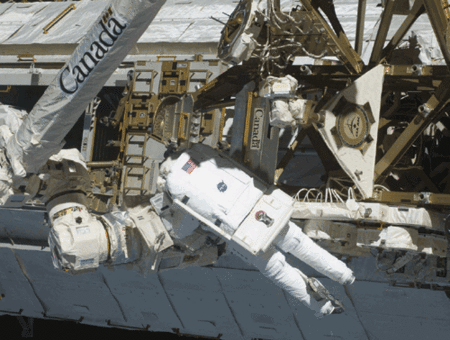Orthopedic surgeon recalls his mission to the space station
Robert L. Satcher Jr., MD, PhD, used his surgical training while performing maintenance and construction on the station.
As the first orthopedic surgeon in space, Robert L. Satcher Jr., MD, PhD, recently joined a select group of individuals who have viewed the Earth from the heavens.
“It exceeded my expectations,” Satcher told Orthopedics Today of his 11-day mission to the International Space Station. “Not too many things in life you can say do that.”
Lift-off
He noted that many of his colleagues in the orthopedic community traveled to Florida to watch his launch on the space shuttle Atlantis.
As the shuttle engines lit at the rear of the shuttle, Satcher recalled feeling the stack sway. When the solid rocket boasters lit, he felt an unparalleled acceleration and adrenaline rush that left him giddy and smiling like a child.
“It is 7 million pounds of thrust coming off of the launch pad,” Satcher said. “I have been in fast cars. I have been in very fast airplanes, but really nothing compares to it. It is just a phenomenal feeling of acceleration and it is 8.5 minutes. You are at 3Gs for most of it, so you are really being pushed back into the seat.”
Phenomenal journey
|
Images: NASA |
Once in space, Satcher said that the journey went too fast. “By the time we were in orbit and got to the space station, our days were busy and jam-packed with activities.”
One of the missions of the group was to perform construction and maintenance on the space station during extravehicular activities (EVAs). Satcher participated on two EVAs, requiring him to perform space walks. He said that being outside of the space station was the highlight of his journey.
“The only thing between you and space, of course is the suit,” he said. “The panoramic view of the earth and the space station and the fantastic views were awe-inspiring. It is hard to capture it in words really. It exceeded my expectations.”
Working above the Earth
Satcher said he had no fear while working 200 miles above the Earth.
“If there was any kind of tendency in me to be afraid, it was overwhelmed by the awe-inspiring view,” he said “I actually felt relaxed and grateful that I had the opportunity to see this.”
His surgical training came in handy during the EVAs. “It was fairly intricate work,” he said, comparing working on a stuck bolt to times he had screws become stuck while performing orthopedic surgery.
Satcher also served as a proxy scientist on the mission and continued work on several studies examining the changes in sleep patterns, the immune system and astronauts’ height in space.
Adapting to space
On his trip, he experienced zero gravity and recalled picking up weightless objects and floating them across the room to crew mates.
“When you are talking to people, you can be in any orientation,” he said. “It is completely different, but your mind quickly adapts to it.”
The crew adapted a work-hard, play-hard philosophy and had a good time during the trip.
“The fact that it was so fun to be around these people is the thing that I think is going to be one of the most lasting memories of it,” Satcher said.
|
|
Lessons from space
He called the mission an educational experience and said he will remember the beauty of the space station and the views of Earth.
“If anything, it shows what we as a country are able to do,” Satcher said. “It is something that is special and that we really should be behind it as much as we can. I know that the administration has reiterated its support of the man-space program and plans on increasing that in the upcoming years. I think that when you go and see it first hand, there is no doubt that that is the right thing to do.”
He added, “We do not know all of the benefits that we are going to get from it. There are certainly many more untold benefits and discoveries that are going to happen as a result of all of this.” – by Gina Brockenbrough
- Robert L. Satcher Jr, MD, PhD, can be reached at Northwestern University, Feinberg School of Medicine, 303 East Chicago Avenue, Chicago, IL 60611; 312-908-7937; e-mail: r-satcher@northwestern.edu.


